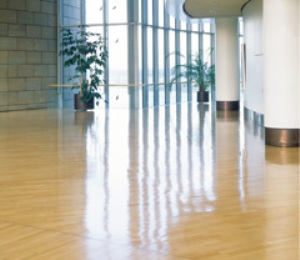Mar 7 2013
People whose job it is to lay parquet, laminate or plastic flooring will generally use a primer and an adhesive or knifing filler. Topcoats, which are either applied at the factory or on site, are also needed to give the floor coverings an attractive appearance. Bayer MaterialScience will present itself at the European Coatings Show 2013 as a “one-stop shop” for the relevant solvent-free raw materials.
 People whose job it is to lay parquet, laminate or plastic flooring will generally use a primer and an adhesive or knifing filler. Topcoats, which are either applied at the factory or on site, are also needed to give the floor coverings an attractive appearance. Bayer MaterialScience will present itself at the European Coatings Show 2013 as a “one-stop shop” for the relevant solvent-free raw materials. The company has now pooled its expertise in this field so that it will be able to provide customers with even better and more comprehensive support in the future.
People whose job it is to lay parquet, laminate or plastic flooring will generally use a primer and an adhesive or knifing filler. Topcoats, which are either applied at the factory or on site, are also needed to give the floor coverings an attractive appearance. Bayer MaterialScience will present itself at the European Coatings Show 2013 as a “one-stop shop” for the relevant solvent-free raw materials. The company has now pooled its expertise in this field so that it will be able to provide customers with even better and more comprehensive support in the future.
“The customer can obtain, from a single source, an exceptionally wide range of high-performance, environmentally friendly binders and also share in our extensive expertise in floor covering applications,” says Karl-Heinz Wührer, a coatings expert at Bayer MaterialScience. The company has now pooled its expertise in this field so that it will be able to provide customers with even better and more comprehensive support in the future.
Many floor coverings are coated industrially immediately after production – to make them insensitive to abrasion and cleaning agents, among other reasons. Particularly suitable for this are solvent-free coatings that cure under UV light. These can be formulated as 100-percent solids systems from raw materials of the Desmolux® line or as waterborne coatings from Bayhydrol® UV dispersions. The big advantage of such coatings is that they cure completely in fractions of a second. This enables faster industrial production of the floor covering elements and means they can be stacked immediately after curing. In addition, UV curing consumes less energy than conventional thermal drying.
UV-curing systems based on solvent-free Desmolux® raw materials or Bayhydrol® UV dispersions can, however, also be used to seal parquet floors or for on-site floor coating, for example to eliminate wear damage. The rapid curing with the help of mobile devices offers the big advantage that the floor is ready to be walked on again as soon as the new coating has been applied.
Where waiting periods of one to three days before floors can be used are acceptable, the best solution is to use conventionally curing waterborne coatings. They, too, can be formulated in two ways: for one-component coatings, Bayer MaterialScience offers a range of Bayhydrol® binders. In waterborne two-component coatings, they are reacted with Bayhydur&® hardeners.
For example, 100-percent solids formulations can be produced by polyaspartic technology using products from the Desmophen® NH and Desmodur® N lines. As regards their overall properties, the resultant waterborne or 100-percent solids floor coatings are certainly a match for conventional solventborne systems. Above all, they are highly resistant to chemicals and mechanical stress. They are also very easy to apply, for example by roller. Primers based on polyurethane raw materials from Bayer MaterialScience have a similar profile. Primers consolidate the substrate, close its pores and prepare it for the process of sticking down the floor covering. When formulating both primers and topcoats, use can be made of two complementary technologies to avoid working with solvents. On the one hand, the range includes the Bayhydrol® and Bayhydur® products for waterborne systems, and on the other, Desmophen® NH and Desmodur® N for 100-percent solids primers.
Anyone wanting to formulate solvent-free floor covering adhesives and knifing fillers would be well advised to contact the raw material specialists from Bayer MaterialScience. For corresponding products with a 100-percent solids content, use can also be made of silane-terminated polyurethane prepolymers of the Desmoseal® S range. Such adhesives are highly crosslinked, and thus offer high strength coupled with high flexibility. They cure free of bubbles without releasing carbon dioxide and thus ensure good footfall sound absorption. An ideal solution for waterborne one-component adhesives comprises polychloroprene dispersions of the Dispercoll® C range. They are noted for their good adhesion. In addition, the adhesive bond is very resistant to moisture and fats.
Raw materials from Bayer MaterialScience allow the formulation of primers, adhesives and coatings that comply with the regulations laid down by the Committee for Health-Related Evaluation of Building Products (AgBB) and the European directives on indoor air quality. They also conform to the criteria for environmental labels such as that issued by the “Gemeinschaft Emissionskontrollierte Verlegewerkstoffe e.V.” (Association for the Control of Emissions in Products for Flooring Installation). It is also important, especially with a view to acceptance by local tradesmen and users of the rooms, that the formulations produced with the Bayer MaterialScience products are virtually odorless.